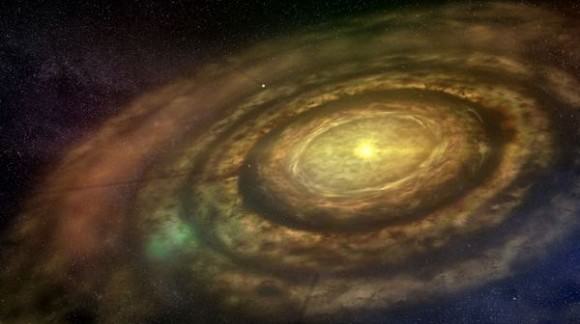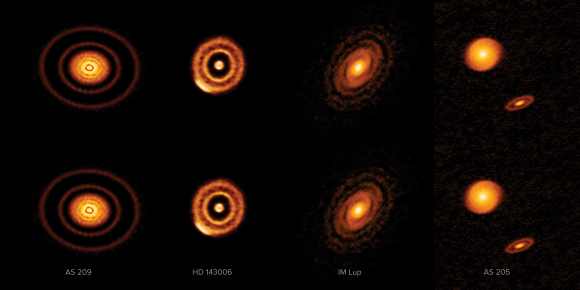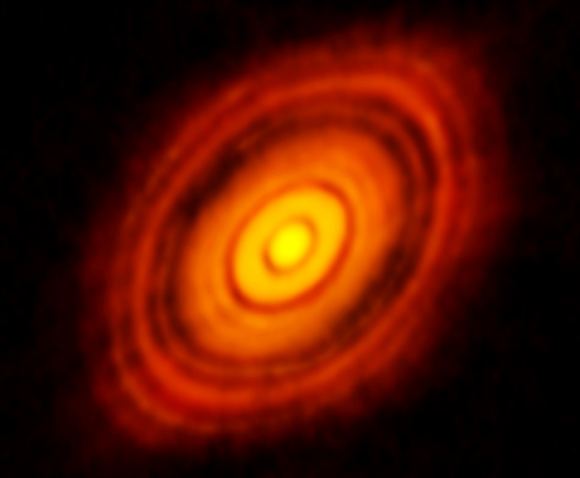The hunt for other planets in our galaxy has heated up in the past few decades, with 3869 planets being detected in 2,886 systems and another 2,898 candidates awaiting confirmation. Though the discovery of these planets has taught scientists much about the kinds of planets that exist in our galaxy, there is still much we do not know about the process of planetary formation.
To answer these questions, an international team recently used the Atacama Large Millimeter/submillimeter Array (ALMA) to conduct the first large-scale, high-resolution survey of protoplanetary disks around nearby stars. Known as the Disk Substructures at High Angular Resolution Project (DSHARP), this program yielded high-resolution images of 20 nearby systems where dust and gas was in the process of forming new planets.
Their results were shared in a series of ten papers that are set to appear in a special issue of The Astrophysical Journal Letters. The team responsible included members from the Harvard Smithsonian Center for Astrophysics (CfA), the Joint ALMA Observatory, and multiple observatories, research institutes and universities.

In each case, the DSHARP researchers noted the presence of gaps in the disk which were far from the central star and seemed to demarcate the inner and outer portions of the disk. The resulting rings were also densely packed or formed thinner bands, depending on their distance from the star. These patterns, they indicated, could be the result of an unseen planetary companion perturbing the disk.
Another possibility is that the disk structures are subject to a global instability similar to those seen in spiral galaxies (like the Milky Way). According to the researchers, the most compelling explanation is that large planets (such as gas giants) were forming predominantly in the outer reaches the disks, which would indicated that planet formation occurs much faster than current theories about planet formation allow for.
This possible explanation would also help to explain how terrestrial planets (i.e. rocky and similar in size to Earth) that form closer to their stars are able to survive the early stages of their formation. Sean Andrews, an astronomer at the Harvard-Smithsonian Center for Astrophysics (CfA) and one of the leaders* of the ALMA observing campaign, explained the significance of these findings in an NRAO press release:
“The goal of this months-long observing campaign was to search for structural commonalities and differences in protoplanetary disks. ALMA’s remarkably sharp vision has revealed previously unseen structures and unexpectedly complex patterns. We are seeing distinct details around a wide assortment of young stars of various masses. The most compelling interpretation of these highly diverse, small-scale features is that there are unseen planets interacting with the disk material.”

According to the leading models of planet formation, planets are born by the gradual accumulation of dust and gas inside a protoplanetary disk. This begins with grains of dust coalescing to form larger and larger rocks until asteroids, planestesimals and planets emerge. This process is thought to take millions of years, which means that protoplanetary disks in older systems would be more visibility impacted by it.
However, early observations conducted by ALMA indicated that many young protoplanetary disks had well-defined structures like rings and gaps. These features are typically associated with the presence of planets, and were even found in a few systems that were just one million years old. As Jane Huang, a graduate student at CfA and a member of the research team, explained:
“It was surprising to see possible signatures of planet formation in the very first high-resolution images of young disks. It was important to find out whether these were anomalies or if those signatures were common in disks.”
Since the early sample set was so small, the DSHARP campaign was mounted to observe other protoplanetary disks for comparison. Since dust particles are known to glow in the millimeter-wavelength, the campaign team was able to use the ALMA array to precisely map the density distribution of dust belts around young star systems and (depending on the distance of the star) to map features as small as a few Astronomical Units.

In the end, the research team found that many of the substructures (i.e. concentric gaps and narrow rings) were common to nearly all the disks, whereas large-scale spiral patterns and arc-like features were more rare. They also found that the disks and gaps were present at a wide range of distances from their host stars – ranging from a few AUs to more than one-hundred.
As noted, these observations could help resolve an enduring mystery when it comes to theories of planet formation. Specifically, astronomers have wondered how planets could form when the dynamics of a smooth protoplanetary disk would cause any body more than a centimeter in diameter to fall into its host star. Under those circumstances, rocky objects larger than an asteroid should not exist.
Essentially, the dense rings of dust the team observed would create perturbations in the disk, which could create zones where planetesimals would be safe and have the time they needed to grow into planets. As Laura Perez, a researcher with the University of Chile and a member of the research team, indicated:
“When ALMA truly revealed its capabilities with its iconic image of HL Tau, we had to wonder if that was an outlier since the disk was comparatively massive and young. These latest observations show that, though striking, HL Tau is far from unusual and may actually represent the normal evolution of planets around young stars.”
This research showcases the power that cutting-edge instruments and scientific collaborations have today. Thanks to the ability to see more and see farther, scientists are able to test astronomical theories like never before. And in the process, our most fundamental notions about how the Universe came to be are being confirmed and challenged.
Be sure to enjoy this animation of what a protoplanetary disk looks like, courtesy of the NRAO Outreach program:
*The other leaders of the ALMA observing campaign are Andrea Isella of Rice University, Laura Pérez of the University of Chile, and Cornelis Dullemond of Heidelberg University.
Further Reading: NRAO

